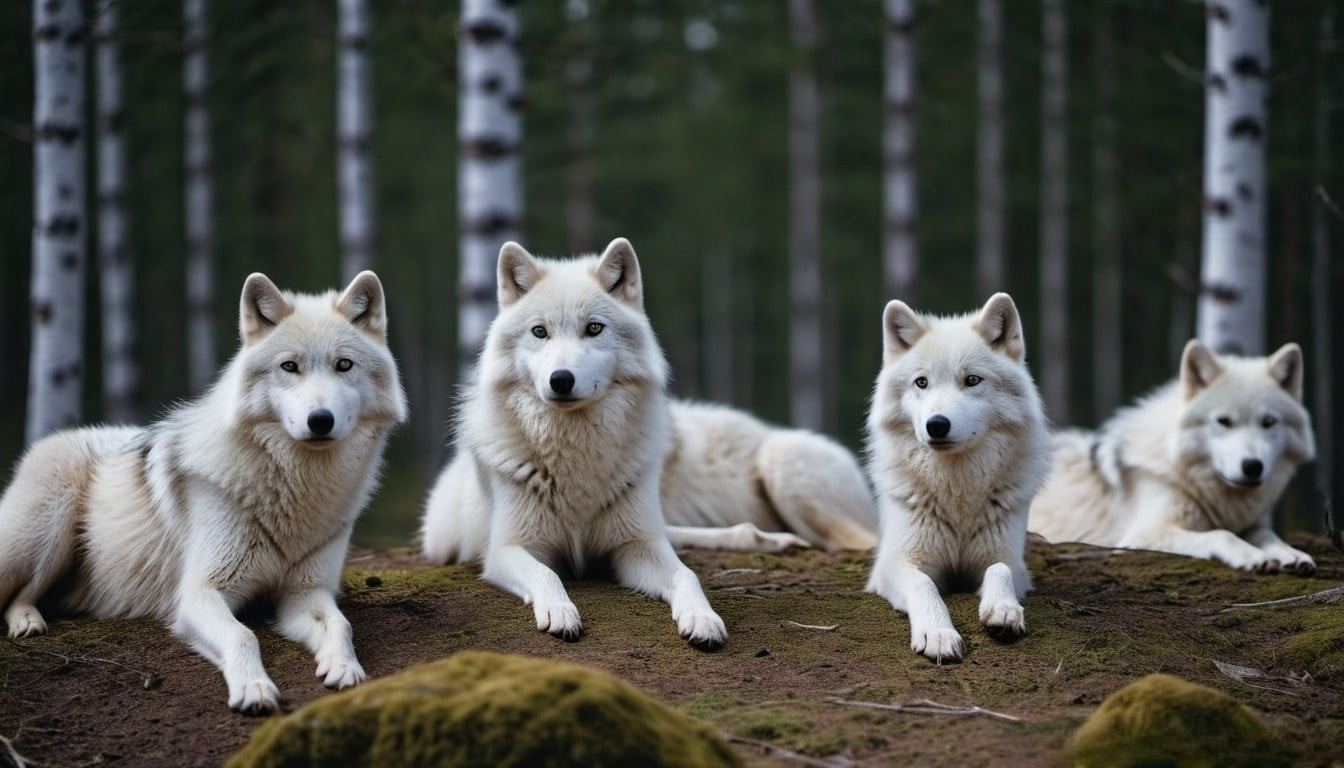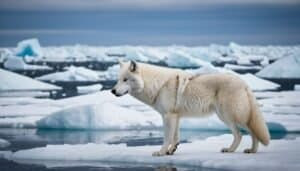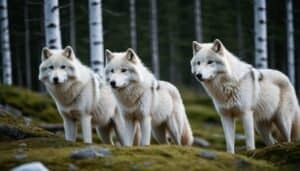Introduction
Arctic wolves, majestic creatures of the northern wilderness, face numerous challenges that threaten their survival
This article delves into the importance of conserving these animals, examining the current status of their populations and identifying major threats. We will explore effective strategies employed by organizations and governments, highlight successful conservation case studies, and discuss the future challenges and directions for Arctic wolf conservation
Overview of Arctic Wolf Conservation
Arctic wolves, also known as white wolves, are a subspecies of the gray wolf that live in the Arctic regions of North America and Greenland
Due to their isolated habitat, they face unique challenges that have necessitated focused conservation efforts. Understanding the importance of these wolves, their current population status, and the major threats they face is crucial for developing effective conservation strategies
Importance of Arctic Wolves
Arctic wolves play a vital role in their ecosystem. As apex predators, they help maintain the balance of species within their habitat. By preying on herbivores such as caribou and muskoxen, they prevent overgrazing, which can lead to habitat degradation
This ecological balance is essential for the health of the Arctic environment
Moreover, Arctic wolves are indicators of the overall health of their ecosystem. Their presence signals a relatively intact and functioning ecosystem. The conservation of Arctic wolves, therefore, extends beyond the species itself to include the broader preservation of the Arctic environment
Current Population Status
The current population of Arctic wolves is estimated to be stable, with numbers ranging from 200 to 300 in certain areas like Greenland. However, exact population numbers are challenging to ascertain due to the remote and inhospitable nature of their habitat
Research conducted by the World Wildlife Fund (WWF) and other organizations indicates that while populations in some regions are stable, others are declining due to environmental changes and human activities
Major Threats to Arctic Wolves
Arctic wolves face several significant threats that jeopardize their survival:
Climate Change: The warming of the Arctic region is altering habitats and affecting the availability of prey. Melting ice and changes in vegetation patterns disrupt the delicate balance of the Arctic ecosystem
Human Encroachment: Although the Arctic is sparsely populated, increased human activity related to mining, oil extraction, and tourism can disrupt wolf habitats. Infrastructure development in these regions can lead to habitat fragmentation
Disease: Arctic wolves are susceptible to diseases such as rabies and canine distemper. Due to their isolated populations, outbreaks can have devastating effects, wiping out entire packs
Pollution: Pollutants such as heavy metals and pesticides can accumulate in the Arctic environment, affecting the health of wolves and their prey
Addressing these threats requires coordinated efforts that include scientific research, policy-making, and community engagement. Conservation strategies must be adaptive and responsive to the dynamic nature of the Arctic environment
Strategies and Role of Organizations
The conservation of Arctic wolves involves a multifaceted approach that includes habitat protection, anti-poaching measures, public awareness campaigns, and the involvement of leading conservation organizations and government policies. Community cooperation also plays a critical role in these efforts
Habitat Protection
One of the primary strategies for conserving Arctic wolves is habitat protection. Preserving large, contiguous areas of the Arctic tundra ensures that wolves have enough space to hunt and roam
Protected areas such as national parks and wildlife reserves provide a sanctuary for these animals, safeguarding them from human encroachment and habitat destruction
Efforts to establish and expand these protected areas have been ongoing. For example, the establishment of the Arctic National Wildlife Refuge in Alaska provides a significant habitat for Arctic wolves and other wildlife. Such protected areas also help maintain the overall ecological balance, benefiting numerous species within the ecosystem
Anti-Poaching Measures
Poaching remains a threat to Arctic wolves, though it is less prevalent than in other wolf populations due to their remote habitat. Nevertheless, anti-poaching measures are essential to ensure their continued protection
These measures include increased patrolling of protected areas, the use of surveillance technology such as drones, and harsher penalties for illegal hunting
Organizations like the World Wildlife Fund (WWF) and local wildlife agencies work together to implement these measures. They provide training and resources to rangers and local communities to help monitor and report poaching activities
Public Awareness and Education
Public awareness and education campaigns are crucial for the long-term success of Arctic wolf conservation. Educating local communities, stakeholders, and the broader public about the importance of Arctic wolves and the threats they face can lead to increased support for conservation efforts
Programs aimed at schools and local communities can foster a sense of stewardship and responsibility. Media campaigns and documentaries can also raise awareness on a larger scale, reaching international audiences
The more people understand the plight of the Arctic wolf, the more support there will be for initiatives aimed at protecting them
Leading Conservation Organizations
Several organizations play a pivotal role in Arctic wolf conservation. The World Wildlife Fund (WWF) is at the forefront, conducting research, advocating for policy changes, and supporting on-the-ground conservation efforts
The Nunavut Wildlife Management Board is another key player, particularly in Canada, where they work closely with Indigenous communities to implement conservation strategies that respect traditional knowledge and practices
Government Policies and Support
Government involvement is critical for the success of conservation programs. Policies that protect habitats, regulate hunting, and mitigate the impacts of climate change are essential
In Canada, the government has implemented various policies aimed at preserving Arctic ecosystems, including the protection of critical habitats and the regulation of industrial activities that could harm wildlife
International cooperation is also important, as Arctic wolves inhabit regions that span multiple countries. Collaborative efforts can lead to more comprehensive and effective conservation strategies
Community Involvement and Cooperation
Local communities, particularly Indigenous populations, have a deep connection to the Arctic environment and play a crucial role in conservation efforts. Engaging these communities in the planning and implementation of conservation strategies ensures that these efforts are culturally sensitive and effective
Community-based monitoring programs, where local residents collect data and monitor wildlife, have proven successful. These programs empower communities to take an active role in conservation and provide valuable data that can inform broader conservation strategies
Successful Case Studies
Examining successful case studies of Arctic wolf conservation provides valuable insights into what works and why. These examples highlight effective strategies and cooperative efforts that have led to tangible improvements in the conservation status of Arctic wolves
Case Study 1: Nunavut Wildlife Management Board
The Nunavut Wildlife Management Board (NWMB) in Canada is a key player in Arctic wolf conservation. This organization collaborates closely with Indigenous communities to integrate traditional knowledge with modern conservation practices
One of their notable successes includes establishing co-management practices that respect Indigenous rights and knowledge
By involving local Inuit communities in the decision-making process, the NWMB has been able to develop and implement conservation strategies that are culturally appropriate and effective. These strategies include controlled hunting regulations, habitat protection, and continuous monitoring of wolf populations
The cooperation between the NWMB and local communities has led to a more sustainable and accepted approach to Arctic wolf conservation
Case Study 2: World Wildlife Fund Initiatives
The World Wildlife Fund (WWF) has launched several initiatives aimed at protecting Arctic wolves and their habitats. One of the most successful projects involves habitat mapping and monitoring
By using satellite imagery and on-the-ground surveys, WWF has been able to identify critical habitats and areas of high ecological value
WWF’s efforts also extend to policy advocacy, working with governments to establish protected areas and implement regulations that mitigate the impacts of climate change and industrial activities. For example, WWF played a significant role in the expansion of the Arctic National Wildlife Refuge, which provides a vital sanctuary for Arctic wolves
Additionally, WWF supports research on Arctic wolf behavior and ecology, which informs conservation strategies and helps to address emerging threats. Their comprehensive approach, combining scientific research, policy advocacy, and community engagement, has contributed significantly to the protection of Arctic wolves
Case Study 3: Reintroduction Programs in Canada
Reintroduction programs have been a critical strategy in areas where Arctic wolf populations have declined. One notable example is the reintroduction program in the Canadian Arctic, where wolves have been reintroduced to areas where they had previously disappeared due to hunting and habitat loss
These programs involve capturing wolves from healthy populations and relocating them to areas where they are extinct or severely depleted. The success of these programs is monitored through tracking and data collection, which allows conservationists to assess the health and adaptation of reintroduced wolves
The reintroduction program in Canada has shown promising results, with several packs successfully establishing themselves in their new habitats
These efforts not only help to restore wolf populations but also contribute to the overall health and diversity of the Arctic ecosystem
Challenges and Future Directions
Despite the successes in Arctic wolf conservation, numerous challenges remain. Addressing these challenges is crucial for the long-term survival of this species
Understanding the impact of climate change, funding and resource allocation issues, and setting long-term conservation goals are essential components for future efforts
Impact of Climate Change
Climate change poses a significant threat to Arctic wolves and their habitat. The warming of the Arctic region has led to changes in the availability of prey and the structure of the landscape. Melting ice and altered vegetation patterns disrupt the natural balance, making it harder for wolves to find food and sustain their populations
As the Arctic continues to warm, permafrost thaw and coastal erosion further threaten the habitats of Arctic wolves. These environmental changes can lead to habitat fragmentation, making it difficult for wolf packs to maintain their territories and access necessary resources
Adaptation strategies are critical in this context. Conservation efforts must focus on protecting critical habitats that are likely to remain stable despite climate change. Additionally, monitoring and research should be intensified to track the effects of climate change on Arctic wolf populations and develop responsive conservation measures
Funding and Resource Allocation
Securing adequate funding and resources is a perennial challenge in Arctic wolf conservation. Conservation programs often rely on government grants, donations from non-profit organizations, and international funding. However, competition for these funds is fierce, and resources are frequently limited
Innovative funding strategies are needed to ensure the sustainability of conservation efforts. Public-private partnerships, crowdfunding campaigns, and increased international collaboration can help to bridge funding gaps
Furthermore, efficient allocation of resources is crucial. Prioritizing high-impact conservation activities, such as habitat protection and community engagement, can maximize the effectiveness of available funds
Long-Term Conservation Goals
Establishing clear, long-term conservation goals is essential for the ongoing protection of Arctic wolves. These goals should be based on scientific research and should address both immediate threats and future challenges. Long-term goals might include expanding protected areas, enhancing legal protections, and promoting sustainable practices that benefit both wildlife and local communities
Setting measurable objectives and regularly assessing progress are important components of effective conservation planning. Conservationists must adapt their strategies based on new data and changing conditions, ensuring that efforts remain relevant and impactful
Another critical aspect of long-term conservation is education and outreach. Building public support for Arctic wolf conservation can lead to increased funding, stronger policies, and greater community involvement. Educational programs and awareness campaigns can play a significant role in achieving these goals
Conclusion
Conserving Arctic wolves requires a comprehensive and collaborative approach, addressing the various challenges they face and implementing effective strategies to ensure their survival. This article has explored the importance of Arctic wolves, their current population status, and the major threats they encounter
Key conservation strategies include habitat protection, anti-poaching measures, public awareness, and the significant roles played by leading conservation organizations and governments. Successful case studies, such as those led by the Nunavut Wildlife Management Board, the World Wildlife Fund, and reintroduction programs in Canada, showcase the potential of well-coordinated efforts
Despite these successes, ongoing challenges like climate change, funding limitations, and the need for long-term conservation goals must be addressed to secure the future of Arctic wolves. Through continued research, adaptive strategies, and community engagement, we can hope to preserve these magnificent creatures and the delicate ecosystems they inhabit










